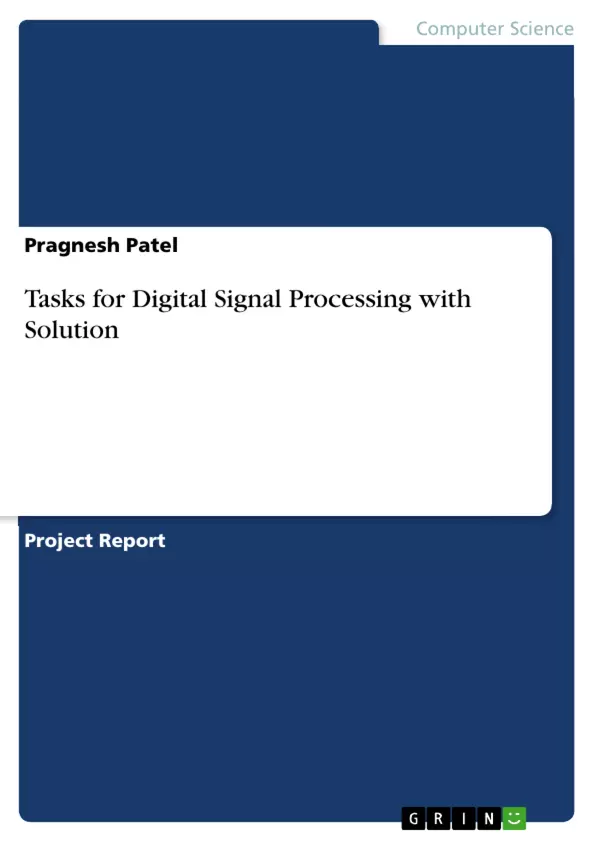Four different tasks in regard to digital signal processing are introduced and solved. The code as well as the output will be given.
Inhaltsverzeichnis (Table of Contents)
- The following continuous-time signal is sampled in the time interval of t = 0 ≤t< 40 *10^-3\nsec and fs = 25000 Hz
- Find the DFT of the resultant discrete-time signal and plot its magnitude versus the "actual" frequency.
- Explain what you see in the graph. (You can use fft command in MATLAB to find the DFT of the signal)
- Let's repeat the above procedure in the time interval of t = 0 ≤t < 38 * 10 ^-3 Sec.
- Why the DFT magnitudes plot is different compared to the one obtained in the previous question?
- Explain. (This effect is called: spectral leakage!)
- Consider the following finite length signals:
- x1 = [1 21-26 0 1 -1 2];
- x2 = [1 -2 4 7 1];
- They both start at n = 0.
- Find the convolution of the signals using the “conv” function in MATLAB.
- Find the convolution of the signals using the DFT and IDFT method. Employ 16-point DFT and IDFT.
- Show that results of part (a) and part (b) are identical (ignore the padded zeros at the end of the signal that you obtained in part (b)).
Zielsetzung und Themenschwerpunkte (Objectives and Key Themes)
This document aims to demonstrate the process of finding the Discrete Fourier Transform (DFT) of a signal and exploring the phenomenon of spectral leakage in the context of signal analysis. It utilizes MATLAB code to illustrate these concepts. * **Discrete Fourier Transform (DFT):** The document explains the calculation and visualization of the DFT of a continuous-time signal sampled at a specific frequency. * **Spectral Leakage:** The document investigates the effect of spectral leakage caused by the non-integer number of periods in the sampled signal. * **Convolution of Signals:** The document explores the convolution of two finite-length signals using both the MATLAB "conv" function and the DFT/IDFT method. * **DFT/IDFT Method:** The document demonstrates how to perform convolution using the Discrete Fourier Transform (DFT) and Inverse Discrete Fourier Transform (IDFT). * **Signal Analysis in MATLAB:** The document utilizes MATLAB to perform signal analysis tasks, including DFT calculation, plotting, and convolution.Zusammenfassung der Kapitel (Chapter Summaries)
The following continuous-time signal is sampled in the time interval of t = 0 ≤t< 40 *10^-3\nsec and fs = 25000 Hz
This section explores the DFT of a specific continuous-time signal sampled at a frequency of 25000 Hz within a time interval of 40 milliseconds. It involves finding the DFT of the sampled signal and plotting its magnitude versus the actual frequency, using MATLAB's "fft" command. The explanation focuses on the interpretation of the obtained graph.Let's repeat the above procedure in the time interval of t = 0 ≤t < 38 * 10 ^-3 Sec.
Here, the same procedure from the previous chapter is repeated, but with a slightly shorter time interval of 38 milliseconds. The document analyzes the resulting DFT magnitude plot and compares it to the plot obtained previously, highlighting the difference caused by spectral leakage. It explains why this occurs due to the non-integer number of periods in the sampled signal.Consider the following finite length signals:
This section investigates the convolution of two finite-length signals: x1 and x2. It demonstrates how to perform convolution using both the MATLAB "conv" function and the DFT/IDFT method. The chapter also shows that the results obtained using both methods are identical, highlighting the equivalence of these approaches.Schlüsselwörter (Keywords)
This document focuses on key signal processing concepts such as DFT, spectral leakage, convolution, and the application of MATLAB for signal analysis. It explores these concepts in detail, using specific examples and MATLAB code to illustrate their practical application. The main focus is on demonstrating the significance of signal processing techniques in understanding and manipulating signals in various engineering and scientific disciplines.
Excerpt out of 6 pages
- scroll top
- Quote paper
- Pragnesh Patel (Author), 2014, Tasks for Digital Signal Processing with Solution, Munich, GRIN Verlag, https://www.grin.com/document/284206
Look inside the ebook



